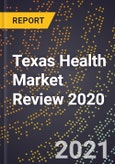In 2019, Texas HMOs Reported a Net Income of $645.4 Million, or 1.6% of Underwriting Revenues
Texas insurers reported much-improved profits in the first nine months of 2020 as expenses for COVID-19 patients were more than offset by lower claims for non-emergent surgeries that were suspended for several months. Most hospitals here saw their profitability increase between 2017 and 2019, even though the number of Texans without insurance has grown in the last two years.
These and other findings are reported in Texas Health Market Review 2020, a new analysis of insurers and hospital systems in the Texas health care market. The report analyzes strategies and competition for health insurers and provider systems in Texas and discusses early measures of the impact of the COVID-19 pandemic.
The new report finds:
- Medical loss ratios for Texas health insurers fell between 2019 and 2020, leading to much stronger profit margins in the first nine months of 2020. Texas HMOs had average medical loss ratios of 81.6% in the first nine months of 2020, five full percentage points less than the same period in 2019. Their average profit margins grew 159% from 2.8% in 2019 to 6.5% in 2020. For example, HMO Blue Texas, part of Blue Cross Blue Shield of Texas, increased its net income from $432.5 million in the first nine months of 2019 to $1.078 billion in 2020.
- Profitability increased for most Texas hospital systems between 2017 and 2019. In Houston, pre-tax net income for hospitals increased by 45.6% from $1.827 billion in 2017 to $2.629 million in 2019. The HCA Healthcare hospitals in the region had a net income of $543.8 million in 2019 or 17.2% of net patient revenues. In the Dallas-Fort Worth area, hospitals had pre-tax net income of $3.144 billion in 2019, up 23.8% from $2.54 billion in 2017. Baylor Scott and White’s hospitals, the largest system in North Texas, reported average margins of 16.3%, while the HCA Medical City hospitals had pre-tax margins of 26.2% in 2019.
- Although the major systems continue to invest in new facilities, the growth of inpatient utilization has slowed. Inpatient hospital days increased by only 1.7% for Dallas-Fort Worth hospitals between 2017 and 2019. Seeking to expand their geographic reach while conserving capital, health systems have increased their investments in micro-hospitals, free-standing emergency departments, ambulatory surgery centres and urgent care clinics. In the San Antonio area, the HCA Methodist system has developed six free-standing emergency departments, while the Tenet Baptist Health system has eight emergency hospitals.
- After declining in 2019, enrollment in Medicaid HMOs increased by 15% in the first nine months of 2020. As a result of the economic downturn last spring and suspension of eligibility verification, enrollment in Medicaid and CHIP in Texas increased from 4.2 million to 4.6 million. AmeriGroup, the largest Medicaid HMO, added 105,000 Medicaid enrollees in the first nine months of 2020.
- Enrollment in Medicare Advantage plans has grown steadily and profitably, and penetration here is higher than the national average. Enrollment in Medicare Advantage plans grew to 1.756 million in 2020, and 41.2% of Medicare beneficiaries are in a private health plan here, more than the national average of 39%. The UnitedHealth Group HMOs have the largest Medicare Advantage enrollment while Humana companies have the most PPO enrollees. Medicare Advantage plans had an underwriting income of $408.8 million in 2019, up from $259.6 million in 2017.
- In 2019, Texas HMOs reported a net income of $645.4 million, or 1.6% of underwriting revenues. HMO Blue Texas had a net income of $300.9 million or 9.4% of underwriting revenues, and Molina Healthcare and the WellCare/SelectCare Medicare plans were also very profitable.
- Enrollment in individual plans increased again in 2020, passing 1 million. Centene, operating here as Ambetter/Superior, is the largest seller of individual plans, with about 338,000 enrollees, followed by HMO Blue Texas.
Table of Contents
Samples

LOADING...
Companies Mentioned
- AmeriGroup
- Baylor Scott and White Health
- Blue Texas (part of Blue Cross Blue Shield)
- Centene (Ambetter/Superior Health)
- HCA Healthcare
- Humana
- Molina Healthcare
- Tenet Health
- UnitedHealth Group
- WellCare/SelectCare
Methodology
The reports analyzing state health care markets are intended to be a resource to health care organizations facing a full range of challenges but also seeking to identify and benefit from opportunities that present themselves.
This report is presented in three main sections. The first part, Market Structure, describes the major health insurers and hospital systems in the state, showing recent entrants and the high-level of consolidation that has occurred in both the health plan and provider markets. Market Trends, the next section, presents our analysis of enrollment trends and financial results for the health insurers. The last section contains our analysis of financial and inpatient utilization data on the hospitals in the state.
The analysis of health plan companies is based on their annual and quarterly statements filed with the Department of Insurance, including forms prescribed by the National Association of Insurance Commissioners and supplemental reports required by the state. The publisher also uses Medicaid data from the Department of State Health Services and Medicare health plan and hospital data from the Centers for Medicare and Medicaid Services. The publisher has that data together with insights that they have gained in interviews with dozens of leaders in health care organizations in the state.

LOADING...








